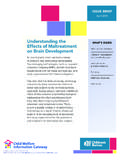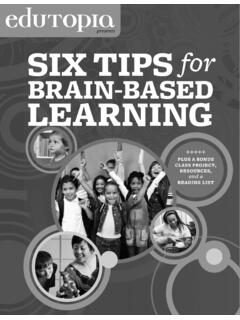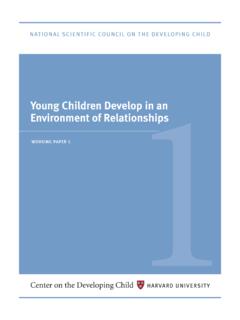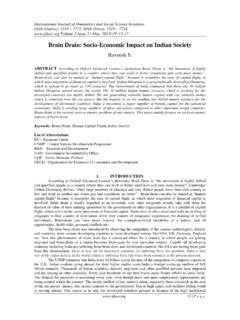Transcription of The Adolescent Brain –Learning Strategies & Teaching Tips
1 Learning Strategies 7 The Adolescent Brain Learning Strategies & Teaching TipsThe Adolescent Brain is still developing and therefore requires different Brain compatible Strategies for learning. This section describes the Adolescent Brain , details specific learning Strategies in Things to Know 1-5 and Brain Compatible Strategies for Increasing Learning, and offers practical tips for Teaching teenagers in Teaching Tips to Keep in Mind When Presenting. Current research states that the Brain undergoes two main periods of increased production of gray-matter: the first begins during fetal development and lasts until around 18 months of age and the second occurs during early Gray matter is responsible for the generation of nerve impulses (processing of the Brain s information), while white matter is responsible for the transfer of Brain information from one lobe to another and out to the spinal cord.
2 This transmission of nerve impulses is assisted by a fatty layer that wraps around the neuron s axon called a myelin sheath. Gray matter does not have a myelin sheath, while white matter does. This myelin sheath allows impulses to travel faster and more efficiently, but isn t fully formed (through a process called myelination) until around age twenty-five,2 with the frontal lobe being the last area of the Brain to be myelinated. The incomplete myelination and rapid growth of gray matter that are characteristic of Adolescent brains do not allow the same cortical connections that occur in adulthood; thus, Adolescent thinking is in a realm of its own. The frontal lobe houses the area of the Brain where we process higher cortical functions like reasoning, problem solving, short term memory, planning and executing behavior, language, motor function, social mirroring, judgment, and impulse control.
3 Until the frontal lobe has matured, other parts of the Brain (temporal lobe, parietal lobe and the amygdala) are used for language development and decision making. Because of the involvement of other parts of the Brain in these functions, adolescents tend to lack impulse control, demonstrate more irrational behaviors, and often make decisions based on their feelings rather than logical thought processing. All of these characteristics affect their ability to is critical to both prospering and surviving. The Brain s main function is to promote survival of the body. However, rather than attending to all the incoming stimuli, the Brain filters out about 99% of the information coming from the senses.
4 Two factors strongly influence whether the Brain pays attention to a piece of information:1. If the information has If the information causes an emotional and emotion are crucial elements to grab the Brain s attention and thereby aid learning. Learning in its simplest form is a process of building neural networks in the Brain . These networks are formed in three different ways through concrete experiences, symbolic learning, and abstract learning. Think about a toddler learning about the names of animals. A concrete experience would consist of taking the child to the zoo to see, hear, smell, and touch the animals. When you return home, you read books and look at pictures of the animals for a symbolic experience.
5 Eventually, children are ready to make generalizations about animals that they did not see at the zoo or in their books - this is abstract thinking. The Brain makes the strongest connections through concrete experiences. Without concrete experiences, symbolic and abstract learning have little or no meaning. Because abstract thought processes are not well-developed until late adolescence (around age 18 to 20), the most effective Teaching styles encompass methods that create concrete experiences within the boundaries of the school StrategiesThing to Know # 1: A young Adolescent Brain can hold seven items of information, plus or minus two items, in working memory.
6 An effective strategy that allows teenagers to work with larger and larger amounts of information is to show them how the information fits together. For example- which list can you recall with more accuracy: NB CLA XC BSD VDA BC or NBC LAX CBS DVD ABC? You can recall the entire second list even though the number of letters and the letters themselves were the same and in the same order because you were able to see how the letters could fit together in a more meaningful way. NBC is now a single item of information, as is LAX and so on. Short-term memory stores about 7 pieces of information for about 30 seconds. If the information is not easily remembered through chunking or other Strategies , it will be quickly forgotten.
7 Working memory stores about 7 pieces of information for 20 to 30 minutes. If the Brain does not determine the information to be meaningful, it is not stored in long-term memory and is lost. Use Brain Compatible Strategies such as Chunking, Storytelling, Mnemonics, and Rhythm, Rhyme, and to Know # 2: The addition of emotion can help students remember. Emotion drives attention and attention drives learning. The young Adolescent Brain does not have a fully developed frontal lobe (which houses higher-level thinking) so many times the thinking gets accomplished by the amygdala (which typically stores emotional memory). Emotion can also work against learning no learning occurs if a student feels threatened.
8 Something as simple as being called on to answer a question or asked to read aloud can produce a threatening situation for some students. Use humor not sarcasm when Teaching . Be careful with humor you do not want to offend any student. Use yourself as the brunt of the joke. Use Brain Compatible Strategies such as Wait Time, Think-Pair-Share, and Reading Buddies to reduce stress. Use Brain Compatible Strategies such as Storytelling and Rhythm, Rhyme, and Rap to make an emotional to Know # 3: The Brain is social & requires interaction in order to develop properly. The Brain s primary function is to promote survival of the body. Hundreds of years ago, a person stood a better chance of surviving as a member of a group versus as an individual.
9 Thus, humans have evolved into social beings and require social interaction in order to mature appropriately. Use Brain Compatible Strategies such as Think-Pair-Share, Simulations, and Reciprocal to Know # 4: Practice/rehearsal is critical to learning for the long term. Understanding must be checked frequently to ensure that the rehearsal is correct. This can be accomplished simply by asking questions such as What do I need to clarify? or What questions might you have? Use of the Socratic Teaching method (asking the audience questions) will allow feedback and verification of understanding. For example, you could ask, I just used the word asymmetry -- can anyone tell me what that means?
10 Use Brain Compatible Strategies such as Analogy, Metaphor and Simile, Simulations, Storytelling, and Rhythm, Rhyme, and to Know # 5: We take in more information visually than through any other sense. We have a tremendous capacity to store pictures in long term memory. Use Brain Compatible Strategies such as Visuals & Graphics, Storytelling, and Hands-on activities. Learning Strategies 9 Brain Compatible Strategies for Increasing LearningStorytelling Can be real or fictional. Should be age- and experience-appropriate. Makes an emotional connection to the Teaching Think, Pair, Share Use anytime you have asked for individuals in a group to make a response, answer a question, give an opinion, etc.






